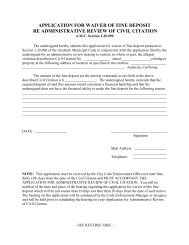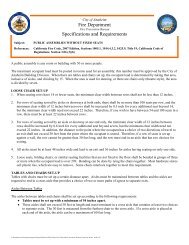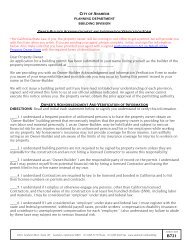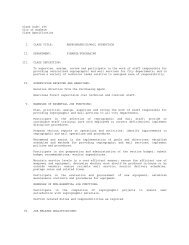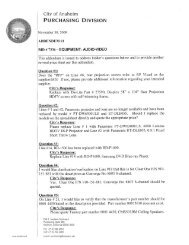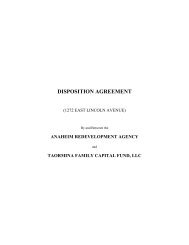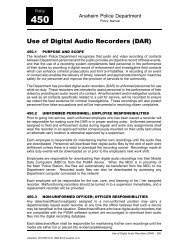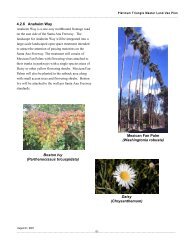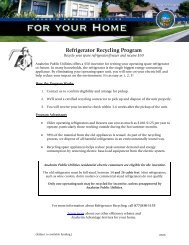AnaheimOUTDOORS - City of Anaheim
AnaheimOUTDOORS - City of Anaheim
AnaheimOUTDOORS - City of Anaheim
Create successful ePaper yourself
Turn your PDF publications into a flip-book with our unique Google optimized e-Paper software.
<strong>Anaheim</strong> Outdoors Connectivity Plan<br />
Rail-with-Trail Research: Guidelines and Standards<br />
May 24, 2012<br />
Because most <strong>of</strong> the rail lines in <strong>Anaheim</strong> are active lines, planning issues and design standards<br />
generally fall in the “rails-with-trails” category. This pertains to a rail right-<strong>of</strong>-way, still being<br />
used by trains, that also includes a recreational trail parallel to the tracks. It differs from<br />
converting part <strong>of</strong> an inactive or abandoned right-<strong>of</strong>-way to a “rail-to-trail”.<br />
A successful rail-with-trail (RWT) project carefully considers the operational needs and other<br />
concerns <strong>of</strong> the railroad, and involves working closely with railroads and other relevant agencies<br />
and landowners during planning and design. The project must balance trail safety with railroad<br />
operations. At its best, a RWT project increases mobility and recreation choices, improves the<br />
appearance <strong>of</strong> the right-<strong>of</strong>-way, enhances property values, brings revenue to the railroad owner,<br />
and can reduce trespassing and injuries or death from illegal track crossings. Although many<br />
railroad owners are reluctant to embrace RWTs, some allow and encourage these projects,<br />
including the Orange County Transit Authority. 1<br />
There are no rigid design standards or guidelines for trails adjacent to active railroads. This is<br />
due to the highly variable nature <strong>of</strong> right-<strong>of</strong> way width, train speed and frequency, land<br />
characteristics and adjacent land uses, right-<strong>of</strong>-way ownership, rail expansion plans, presence <strong>of</strong><br />
utilities in the right-<strong>of</strong>-way, and occasional narrowing <strong>of</strong> the corridor because <strong>of</strong> topography,<br />
bridges, etc. Surveys <strong>of</strong> existing RWTs confirm this variability and emphasize that trail planning<br />
and design is done on a case-by-case basis, to meet the specific needs <strong>of</strong> the railroad operator and<br />
provide a safe and functional rail-with-trail corridor. 2 The following trends and design<br />
recommendations are gleaned from existing RWTs (summarized in reports listed in the<br />
Reference section), including 21 projects in California.<br />
Feasibility and Planning<br />
A feasibility study must evaluate any proposed RWT, and should include analysis <strong>of</strong> an<br />
alternative trail alignment outside the rail right-<strong>of</strong>-way. If the project proceeds as a RWT,<br />
planning should involve the rail owner/operator from the earliest stages. Reluctant rail operators<br />
may feel more comfortable with the project if it adequately addresses issues beyond safe trail<br />
design, including liability, indemnification, design approval by the rail operator, and<br />
maintenance access. In some cases, the project may proceed only if the portion <strong>of</strong> right-<strong>of</strong>-way<br />
1 Rails-with-Trails: Lessons Learned—Literature Review, Current Practices, Conclusions. U.S. Department <strong>of</strong><br />
Transportation, August 2002.<br />
2 The design also must meet other applicable standards (e.g., California Department <strong>of</strong> Transportation’s Highway<br />
Design Manual, Chapter 1000, “Bikeway Planning and Design”; California Department <strong>of</strong> Transportation’s<br />
California Manual on Uniform Traffic Control Devices; Guide for the Development <strong>of</strong> Bicycle Facilities, prepared<br />
by the American Association <strong>of</strong> State Highway & Transportation Officials (AASHTO); and National Bicycle and<br />
Walking Study – Current Planning Guidelines and Design Standards Being Used by State and Local Agencies for<br />
Bicycle and Pedestrian Facilities, prepared by the Federal Highway Administration; and any standards issued by the<br />
<strong>City</strong> <strong>of</strong> <strong>Anaheim</strong>.)




